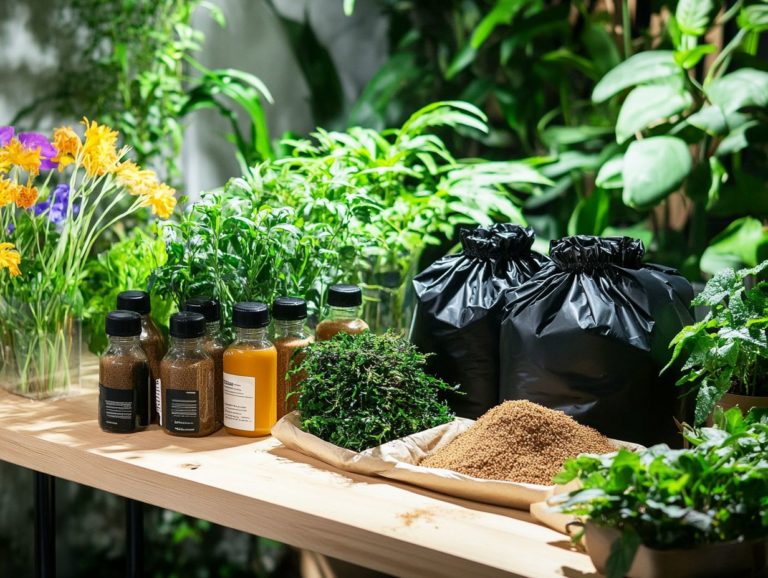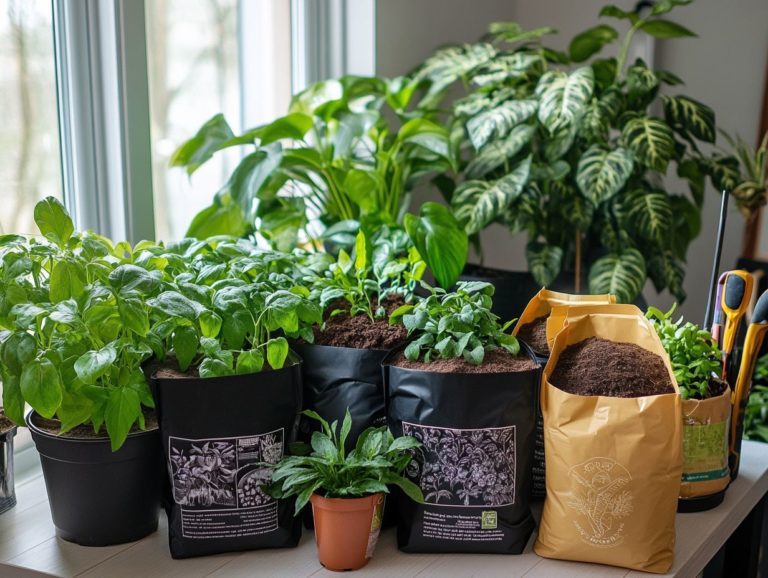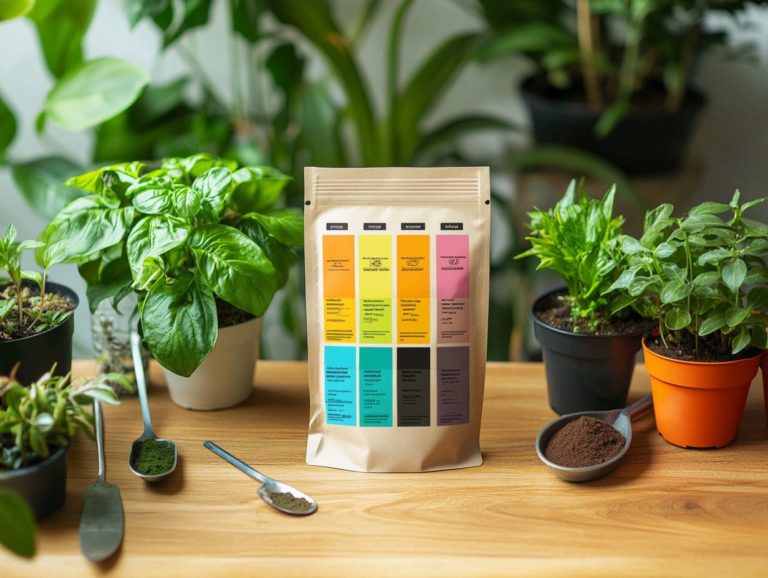Maintaining Soil Fertility: A How-To Guide
Soil fertility is the cornerstone of successful agriculture and thriving ecosystems. Understanding what soil fertility entails, the factors that influence it, and the methods to maintain it including effective soil management techniques is essential for anyone passionate about gardening or farming.
This exploration delves into the significance of soil fertility, examining the various elements that impact it, and presenting practical strategies like crop rotation, cover crops, composting, and soil testing.
By embracing sustainable practices, such as using organic matter and biological control methods, you can take action now to keep your soil healthy for the future! Unlock the secrets to thriving soil today!
Contents
Key Takeaways:

- Soil fertility is the ability of soil to support plant growth and maintain a healthy ecosystem.
- Soil fertility provides essential nutrients and supports beneficial organisms.
- Crop rotation, composting, and regular soil testing are effective methods for maintaining soil fertility and ensuring sustainable practices for long-term health.
Understanding Soil Fertility
Understanding soil fertility is essential for agricultural success, as it involves the delicate balance of nutrients and organic matter within the soil. This balance supports plant growth and enhances the overall health of ecosystems.
Several factors influence soil fertility, including biological activity think microorganisms and beneficial organisms like earthworms along with the physical structure and chemical composition of the soil itself.
By prioritizing optimal soil fertility, you can foster robust nutrient movement and create sustainable agricultural systems that are resilient in the face of changing environmental conditions.
What is Soil Fertility?
Soil fertility is all about the soil’s ability to provide essential nutrients to plants, which supports their growth and overall productivity. This capability mainly depends on key nutrients like nitrogen, phosphorus, and potassium, critical for various plant functions.
Organic matter plays a vital role here; it enhances nutrient availability, improves soil structure, and boosts moisture retention. Soil pH is among the factors influencing soil fertility, affecting how well nutrients dissolve and are absorbed by plants.
Microbial activity is also crucial. It helps break down organic materials and facilitates nutrient movement. A balanced ecosystem of microorganisms can significantly enhance nutrient availability, promoting healthier and more robust plant growth.
Importance of Maintaining Soil Fertility
Maintaining soil fertility is essential for ensuring optimal plant growth and supporting vibrant ecosystems. It directly influences agricultural practices, enriches biodiversity, and enhances your crops’ resilience against pests and diseases.
Prioritizing soil health not only benefits your yields but also contributes to the overall well-being of the environment.
Benefits for Plant Growth and Ecosystem
Healthy soil fertility is key to unlocking enhanced plant growth and fostering vibrant ecosystems. It facilitates nutrient uptake, improves water retention, and provides a thriving habitat for a diverse array of soil organisms.
When your soil is rich in essential nutrients like nitrogen, phosphorus, and potassium, plants can absorb these elements more effectively, promoting robust growth and boosting yields. Think of healthy soil as a sponge efficiently managing water supply and reducing erosion, which is especially critical during droughts.
But it doesn t stop there. Fertile soil nurtures a plethora of organisms, from earthworms to microbes, each playing a vital role in recycling organic matter and cycling nutrients. This biodiversity not only enhances soil health but also supports essential ecosystem services like pollination and pest control services vital for sustainable agriculture and resilient ecosystems.
Factors Affecting Soil Fertility

Several factors influence soil fertility. These include soil composition, nutrient depletion, biological activity, and hardpan, which hinders root growth and water movement.
Understanding these elements is vital for optimizing soil health. Healthy soil leads to productive growth.
Nutrient Depletion and Soil Composition
Nutrient depletion occurs when essential nutrients are used faster than they can be replaced. This is often due to intensive farming and insufficient organic matter.
Practices such as monoculture, excessive use of chemical fertilizers, and poor crop rotation deplete critical minerals like nitrogen, phosphorus, and potassium. Healthy soil supports plant growth, improves water retention, and fosters biodiversity.
Organic matter is essential as it stores nutrients and enhances soil structure. For example, planting legumes like clover or beans enriches the soil by fixing nitrogen.
Methods for Maintaining Soil Fertility
To maintain soil fertility, consider these practices:
- Crop rotation
- Utilizing cover crops
- Composting
- Integrated soil management
These methods enhance nutrient cycling and improve pest management. They help create a thriving ecosystem for your crops.
Crop Rotation and Cover Crops
Crop rotation and cover crops effectively enhance soil fertility. These practices help prevent nutrient depletion and improve soil structure.
By alternating crops, you can break pest and disease cycles, letting your soil recover. Incorporating legumes into your rotation enriches the soil and boosts biodiversity.
Cover crops like rye or vetch protect the soil from erosion and compaction. Embracing these practices leads to sustainable agricultural success!
Composting and Mulching
Composting and mulching are vital for maintaining healthy soil. They significantly enhance organic matter and overall fertility.
Composting transforms organic materials, like kitchen scraps, into rich humus. Mulching covers the soil with organic matter to conserve moisture and suppress weeds.
These practices improve nutrient profiles and enhance soil structure. By using composting and mulching, you pave the way for healthier plants and greater yields.
Using Fertilizers and Soil Amendments
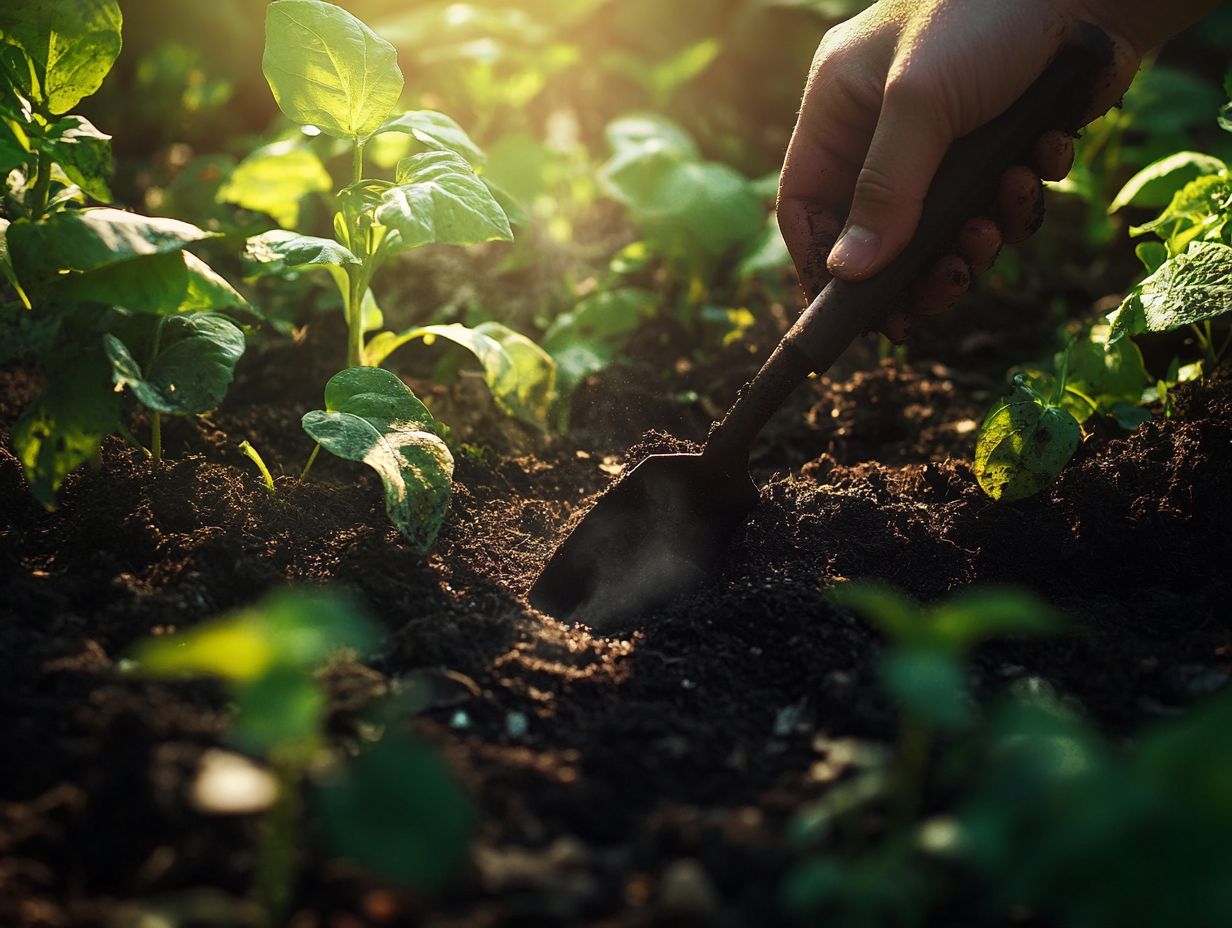
The strategic use of fertilizers and soil amendments can truly elevate your soil fertility. They replenish essential nutrients and enhance nutrient cycling within the soil ecosystem. This practice invigorates plant growth while supporting the overall health of the ecosystem.
You’ll find that various types of fertilizers, both organic and inorganic, offer specific benefits tailored to address different soil deficiencies. For instance, organic fertilizers derived from natural materials like compost and manure improve soil structure and help good bacteria grow. On the other hand, synthetic options provide concentrated nutrients quickly when your plants need them most.
Don’t overlook amendments such as lime and gypsum; these can effectively alter soil pH and mineral composition. They are vital for optimizing your crop yields. However, applying these inputs correctly is crucial. Improper application can lead to nutrient runoff, which ultimately harms waterways and degrades soil quality. So, precision is key to ensuring your efforts truly pay off.
Testing and Monitoring Soil Fertility
Testing and monitoring soil fertility are essential practices that give you the ability to evaluate nutrient levels, soil pH, and the overall health of your soil. By doing so, you can make informed decisions regarding your management practices. This ensures optimal growth and productivity in your endeavors.
How to Test Soil Fertility
Soil fertility can be evaluated through an array of testing methods, from professional laboratory analyses to user-friendly DIY kits. These options offer valuable insights into nutrient levels and soil pH.
To ensure precision in your assessment, begin by collecting representative soil samples from various spots within your garden or field. It’s essential to clear away any surface debris and dig about six inches deep, as this depth typically captures the root zone.
Once you ve gathered your samples, mix the soil thoroughly. Allow it to dry and store it in a clean container. The next step hinges on your specific needs. Laboratory tests typically deliver more comprehensive results, making them ideal for dedicated gardeners or farmers. In contrast, DIY kits can provide quick insights, perfectly suited for casual gardeners looking to understand their soil’s health without the fuss.
Let s dive into how to interpret these results effectively.
Interpreting Results and Making Adjustments
Interpreting soil test results is essential for grasping soil fertility. It also helps in making the necessary adjustments to your nutrient management practices for optimal crop production.
By decoding these results, you can pinpoint specific nutrients that may be lacking or in excess. This allows you to implement tailored amendments that encourage robust plant growth. Common deficiencies, such as nitrogen, phosphorus, or potassium, can lead to stunted development and poor yields. This underscores the importance of taking prompt action.
Understanding pH levels and micronutrient availability is also crucial. By aligning your management practices with soil health, you not only enhance fertility but also promote sustainable farming methods. These methods benefit the ecosystem while maximizing productivity over time.
Sustainable Practices for Long-Term Soil Fertility
Implementing sustainable practices is essential for ensuring long-term soil fertility. These exciting methods not only protect our soil but also boost biodiversity and resilience! They safeguard the soil from erosion and degradation.
Embracing these strategies will lead to healthier ecosystems and a more resilient environment for future generations. Start implementing these strategies today for a healthier tomorrow!
Conservation Techniques and Best Practices
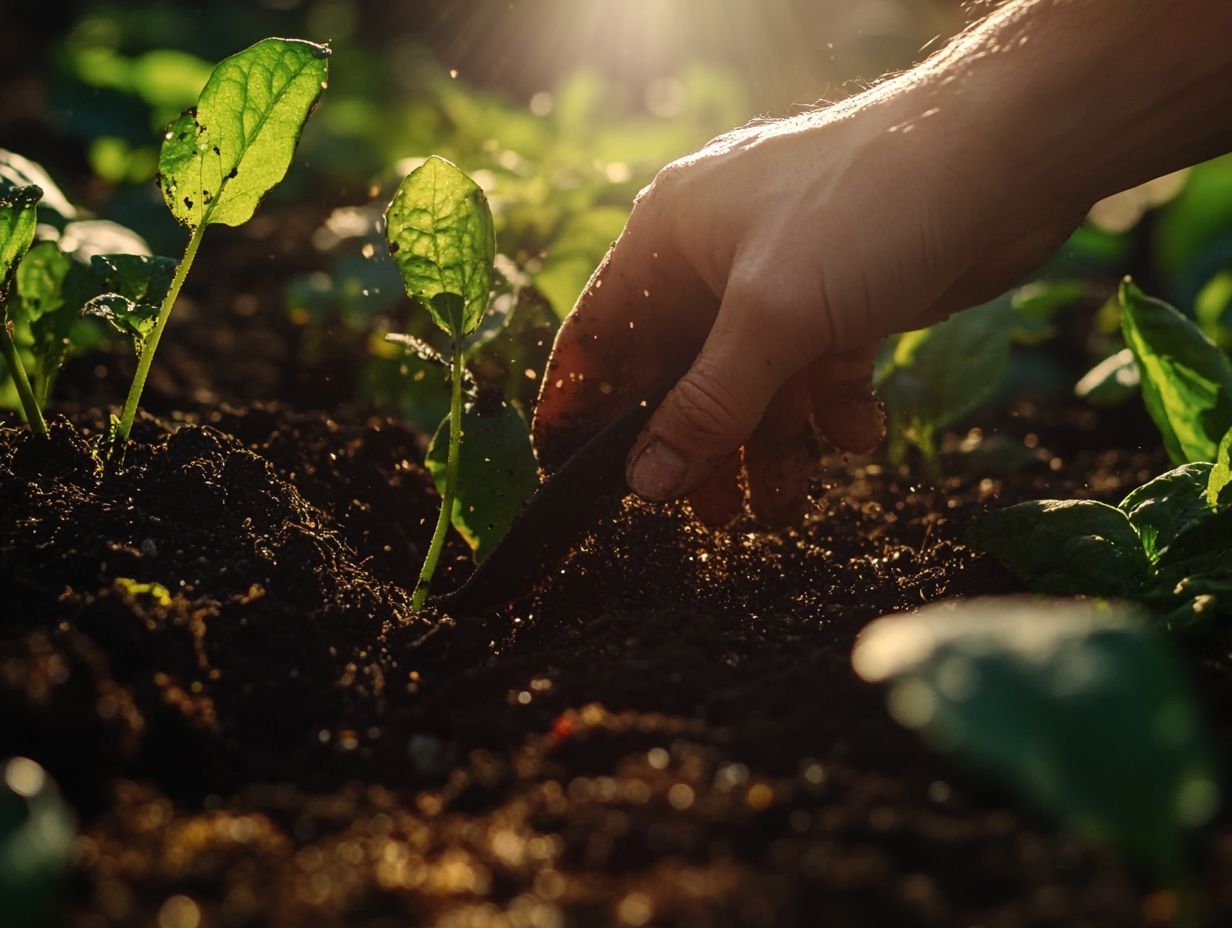
Conservation techniques and best practices are essential for maintaining soil fertility. They concentrate on erosion control, reduced tillage, and the preservation of soil structure.
By adopting practices such as cover cropping and crop rotation, you ll see a remarkable boost in the organic matter in your soil. This fosters a more resilient ecosystem. These methods not only reduce nutrient loss but also improve water retention. They ensure that your soils remain productive, even in dry spells.
Incorporating agroforestry and buffer strips creates natural barriers against wind and water erosion, effectively protecting your valuable topsoil. Using compost and organic amendments can supercharge microbial activity, securing sustainable fertility that supports long-term agricultural success.
Frequently Asked Questions
What is soil fertility and why is it important?
Soil fertility refers to the ability of soil to support plant growth and sustain plant life. It is important because it directly impacts the productivity of crops and the overall health of the ecosystem.
How do I keep my soil healthy?
The key components of maintaining soil fertility include proper nutrient management, organic matter management, soil conservation, and soil testing and analysis.
How can I maintain soil fertility in my garden?
To maintain soil fertility in your garden, you can use organic fertilizers, practice crop rotation, and use cover crops. It is also important to avoid over-tilling and to regularly test your soil to ensure it has the necessary nutrients.
What are some common ways to improve soil fertility?
Some common ways to improve soil fertility include adding compost or manure, using green manures and cover crops, and incorporating crop rotation and proper tillage practices.
Why is soil testing important for maintaining soil fertility?
Soil testing is important because it helps determine the nutrient levels and pH balance of the soil. This information can then be used to make informed decisions about which fertilizers or amendments to use to maintain soil fertility.
What are the consequences of not maintaining soil fertility?
If soil fertility is not maintained, it can lead to decreased crop yields, nutrient deficiencies in plants, and soil erosion. It can also have negative impacts on the overall health of the ecosystem and contribute to soil degradation.
Ready to boost your garden s soil fertility? Start implementing these techniques today!


